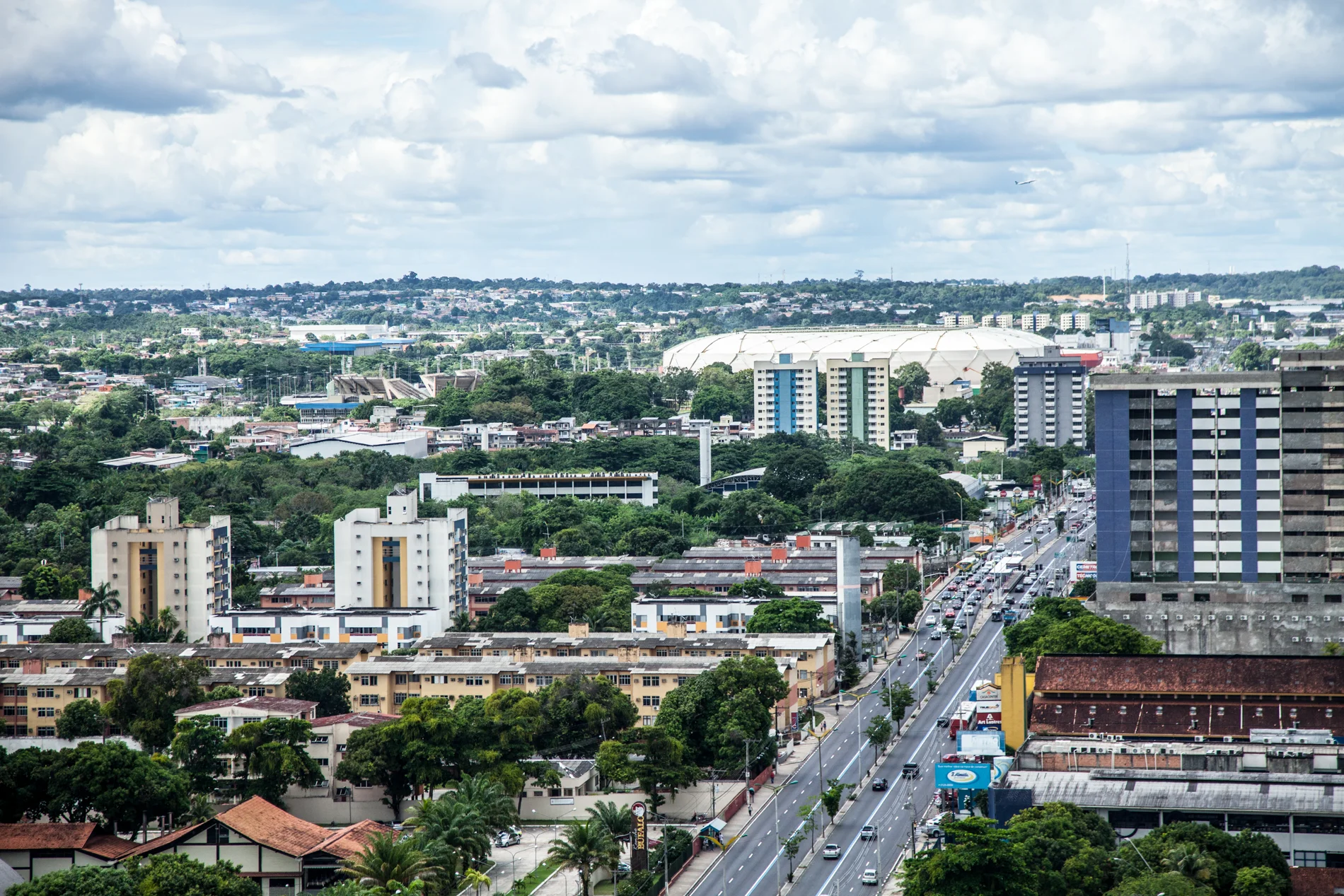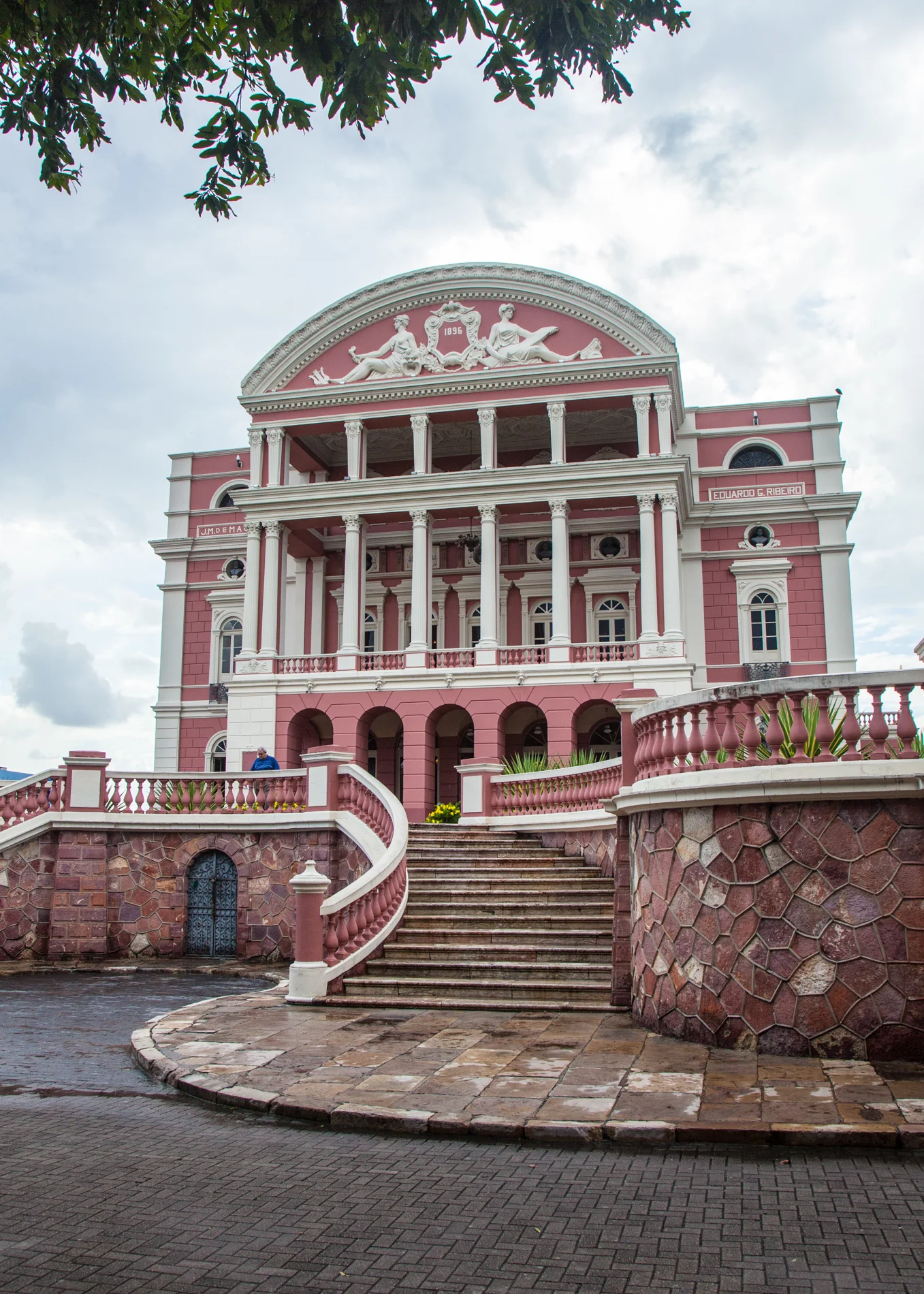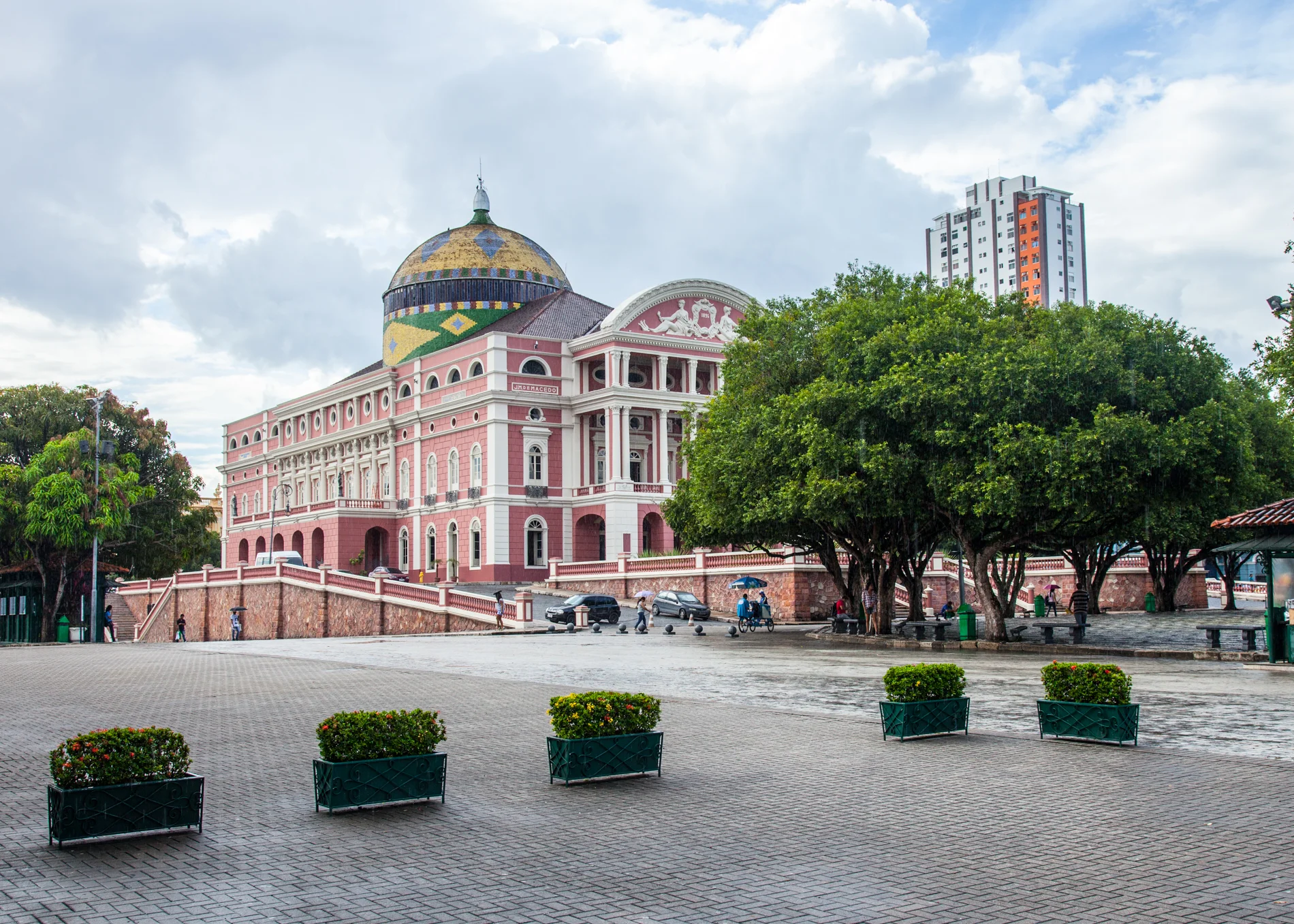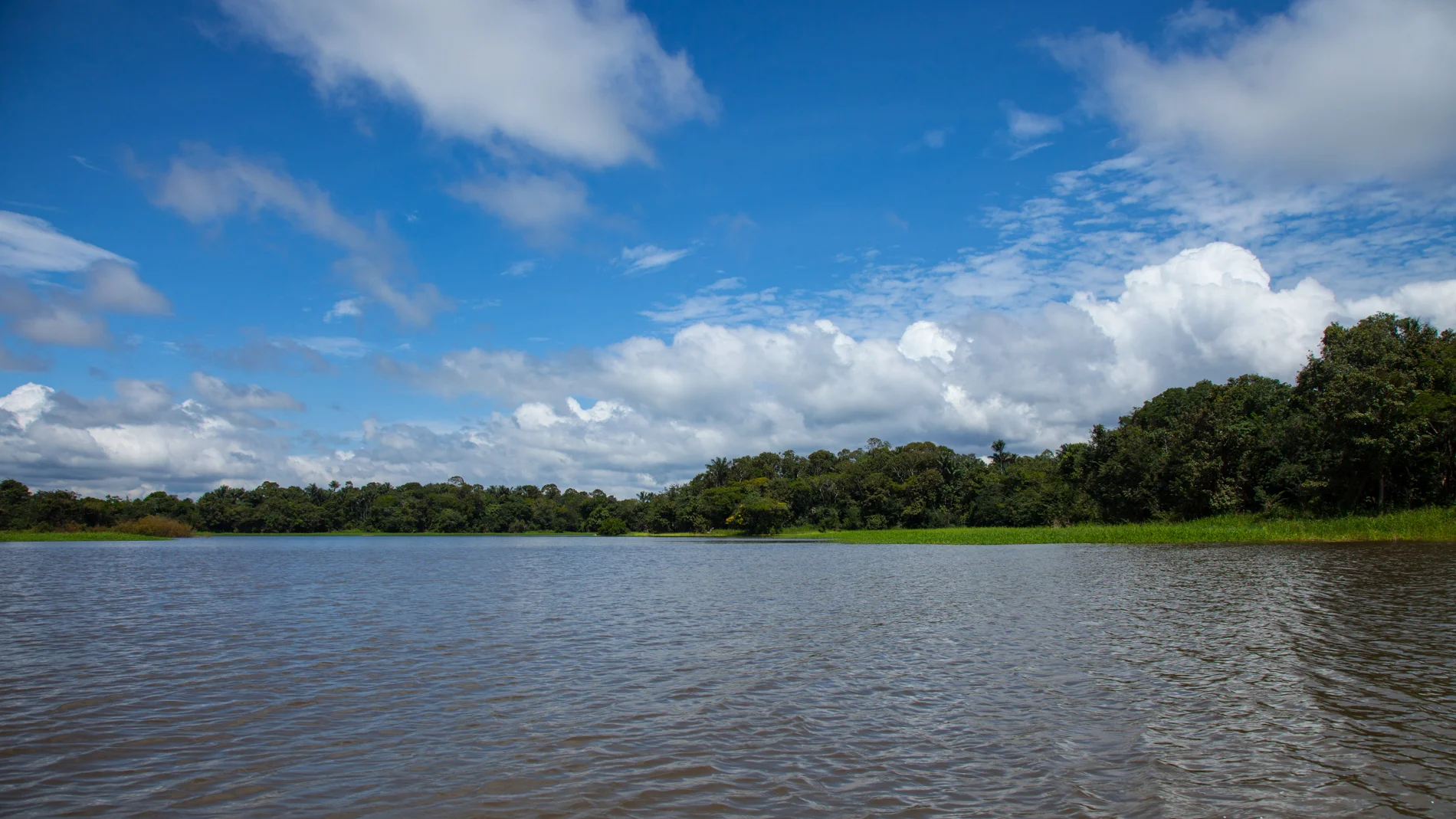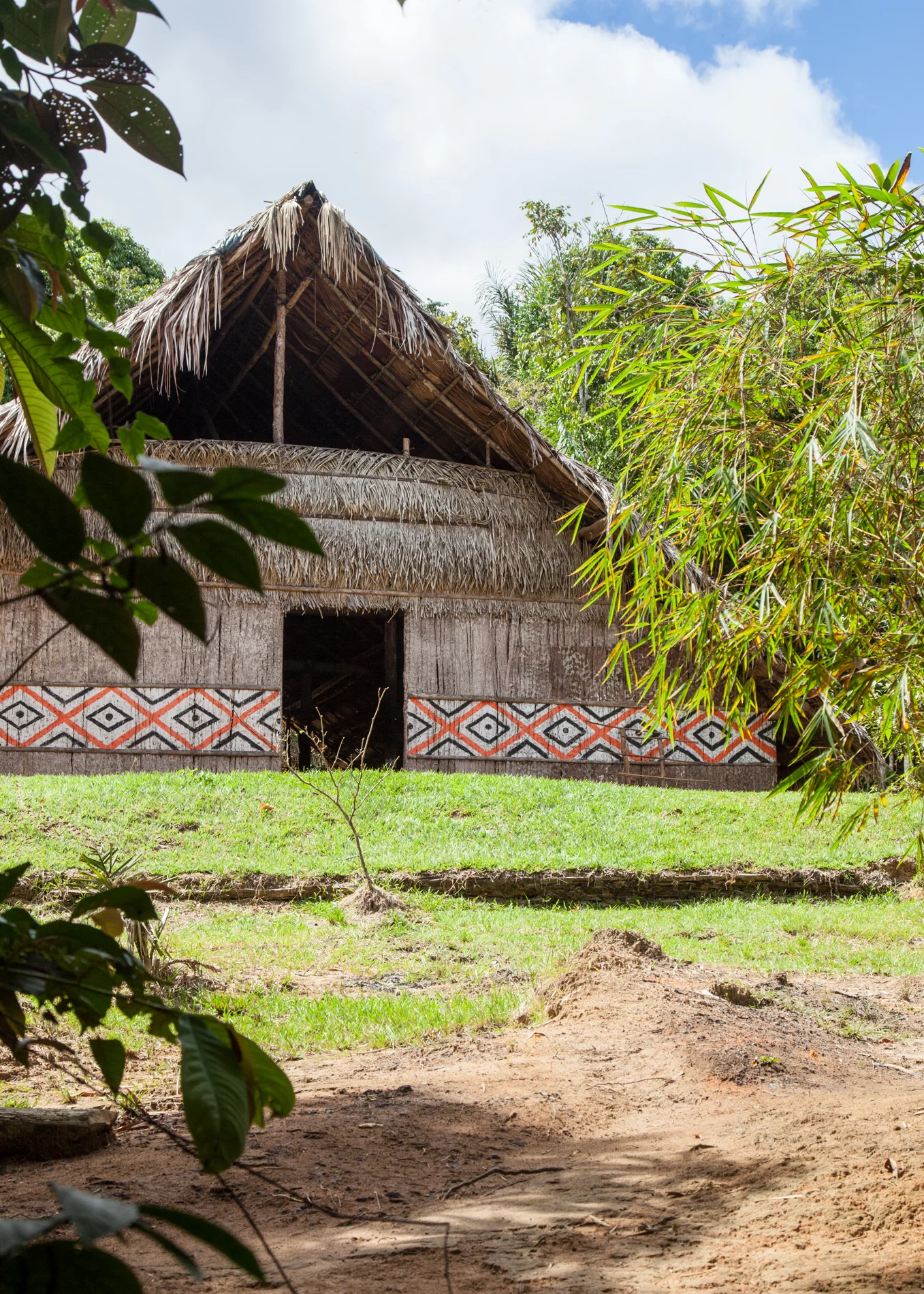We got into Manaus from Brasilia in the mid-afternoon, and while it was warm, it wasn't as bad as I had been led to believe. As all of us were feeling good, we decided to head out to explore the city directly. While Paul and Mike had both been here before, neither of them had really explored much of the city.
The view from the roof of the hotel. The new football stadium was still being completed for the World Cup. England will be one of the four games being played in the new $900M stadium. $900M for 4 games - it's a pretty expensive project, given that the local team only draws about 5,000 people a game. It looked nice, so that's something...
We had the taxi drive us down to the main part of town, and dropped us off outside the Opera House. The Opera House was built in the late 1800s, when Manaus was the heart of an economic boom around rubber, and rubber plantations. The Opera House is beautiful, and must have been a marvel at the time.
The front of the Opera House.
Gardens out front of the Opera House.
The grand facade of the Opera House
The area around the Opera House was quite nice. There was a large square out front, with a big fountain that reminded me of Lisbon. Not surprising I guess. We ended up walking around the area, checking out some of the stores and the markets, before making our way down to the waterfront.
The mosaic stone work on the plaza was very similar to many tat I had seen on my trips to Lisbon. You can see the done from the Opera House just above the trees.
There is a large market, right on the waterfront that we explored for a bit, then walked around on the docks where the boats leave to do the multi-day Amazon tours. It was much as you would expect - a bit of a hustle on the tourists, lots of noise and commotion, and pretty loud. I git my first look at the Amazon - or at least half of it, as we were on the one arm, the Rio Negro. More about that later.
After wandering for a bit we sat in a plaza not far from the water and order a couple of beers, and spent a couple of hours chatting and people watching. Needless to say, there were lots of characters to check out.
One final look at the Opera House, from across the main square.
Friday was our meeting with the CENSIPAM office in Manaus, and we had a great day. We got good feedback from our customer, and learned of a new, big opportunity. So I think that all aspects of the trip were very good. That night we all headed out for dinner again, before Flavio, Mike and Paul headed to the airport for their late night flights home. I was sticking around for an extra couple of days, and flying home on Sunday. I figured that I had come far enough that I needed to at least see the Amazon.
Saturday morning I had booked a day trip on the Amazon. So I was up pretty early to head back downtown to the main ferry terminal to catch the boat. It was a pretty typical tourist type trip, but as I only had one day, there wasn't a lot of choice.
As I walked across to the dock where we got on the boat, you walk by this massive plaque showing all the water levels by year. This year it was quite low, but 2012 had been one of the highest levels. The difference is pretty crazy.
We set out from port and headed to the first stop on the tour - The Meeting of the Waters. Manaus is the start of the Amazon river, where two massive rivers come together. To date, we had only seen the Rio Negro, but this location is the confluence between the Rio Negro, a river with dark (almost black coloured) water, and the sandy-colored Rio Solimões, creating the Amazon. For 6 km (3.7 mi) the river's waters run side by side without mixing.
It's pretty hard to imagine, but these two rivers literally run side-by-side, and do not mix. It's pretty amazing to see.
The Rio Negro (top) and Rio Solimões (bottom).
According to Wikipedia, this phenomenon is due to the differences in temperature, speed and water density of the two rivers. The Rio Negro flows at near 2 km per hour at a temperature of 28°C, while the Rio Solimões flows between 4 to 6 km per hour a temperature of 22°C. The boat pilot drove us back and forth between the two parts of the river, and you could drag your hand through the water and feel the difference in temperature. I swam in the Rio Negro later in the day, and it was almost too warm to be comfortable.
The two waters really do not mix.
After experiencing that crazy phenomenon, we headed back up the Rio Negro for the rest of our tour. All along the river, people live in these small floating villages. All the houses, and even shops and schools are built on platforms floating on massive logs. It's pretty cool to see. We did a drive by of one of these villages.
The floating school house
At this stage we had an "experience" that pretty much turned me off the whole trip. As we were heading up the river, a group of three locals in a canoe waved us over, and the pilot of our boat pulled up along side. The three boys had some local wildlife - a caiman, a python and a baby sloth that they were offering the tourists to hold and take their pictures with them. For a donation of course. I refused to participate, as I hate seeing animals treated like that. The caiman had a hole drilled in it's lower jaw, and had it's mouth held shut with fishing line. The python looked totally emaciated, and the sloth couldn't have been more than a couple months old. It was pretty disgusting.
Even at only half it's size, the Rio Negro is a huge river. Very beautiful on a very nice day.
A sloth, up in one of the trees along the boardwalk. At least this one was living wild.
After leaving that unpleasant scene, we headed further up the river, to our lunch stop. This was a restaurant floating on the river, where we had some decent food. The fish from the Amazon are huge, and have a very unique taste, which I quite liked.
As you might expect, the lunch stop was stocked with horrible souvenirs for tourists to buy. As a redeeming feature, it did have a boardwalk that took you a little ways into the jungle and ended up at a small lake with these massive lily pads. That was kind of cool.
Monkeys!
As you might expect, there was a troupe of monkeys that are well trained to try and extract food from the tourists along the boardwalk. It gave me a chance to get some good shots of the little guys. I also happened to see a sloth, way up in one of the trees, which was very cool.





The Manaus Iranduba Bridge (called Ponte Rio Negro in Brazil) is a bridge over the Rio Negro with 3,595 metres (11,795 ft) of length that links the cities of Manaus and Iranduba. We went under it a couple of times on our tour.
After lunch we headed further up the river, possibly up another branch of the Rio Negro, but I'm not sure. Our first stop after lunch was at native village, where we we treated to a short show by the locals, dressed in their full traditional garb. I'm not normally a big fan of these type of shows (I figure they all go put jeans on afterwards and head into town, but maybe I'm just cynical), but this one was pretty interesting.
The traditional community dwelling.
The Chief
The oldest and the youngest

You can really see the colour of the Rio Negro, just outside the village. It looks like tea, more than river water. The colour comes from the tannins in the trees, that leach into the water.
After leaving the village we headed further up the river, to my favourite part of the trip - I got to swim with river dolphins! This was pretty cool, and handled (so it seemed) much better. There was another house floating in the river, and it looked like the dolphins stick around because they get fed, and they seem to enjoy the interaction.
The river dolphins have much longer snouts than ocean-going dolphins, and adaptation I'm sure that comes from hunting for fish in those murky conditions.
It was all very cool. We got to jump in the water, then the local guy came in with us and coaxed the dolphins out with fish. You can't see your own body in the water, it's that dark, and so all of a sudden these huge animals are swimming around you, bumping you a bit - its was pretty amazing. The guy that was feeding them would try and get them as far out of the water as possible, which led to them jumping a bit, and I had the big one land on me at one point!
Under the water, the dolphins look pink from the colour of the water.
The water itself was really warm - at 28 degrees I'm not sure I've been in a river or even a lake that was that warm. It really got uncomfortable after a while. But it was too much fun being with the dolphins.




After that adventure it was just a fairly long trip back to Manaus. Overall, i'd say it was a "good" trip - there were some negatives, but the positives outweighed them for sure.
I went to bed fairly early, ahead of my flight back to Sao Paulo, which then connected me back to Toronto and Vancouver. It was a very long set of flights, but fortunately I was upgraded again from Sao Paulo to Vancouver, which made the trip much more pleasant.
